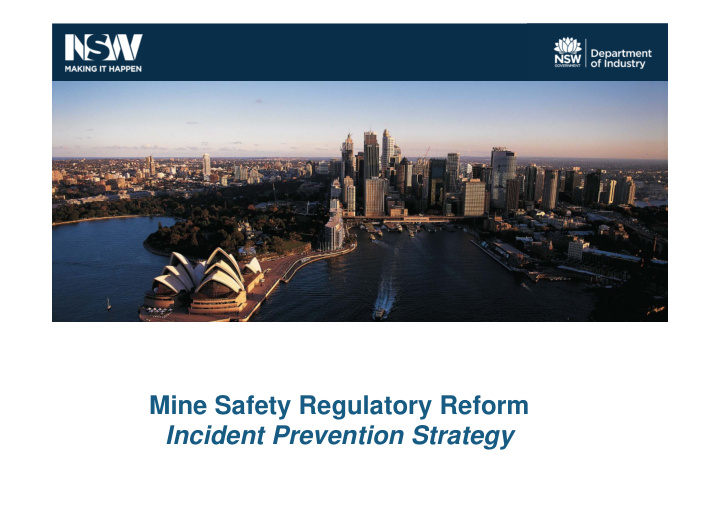



June 2016 Mine Safety Regulatory Reform Incident Prevention Strategy
Today’s outline • Overview of the IPS • Targeted assessments and interventions • Primary contact inspector • Centralised reporting • Communications • Future developments Page 2
Setting our regulatory scene Our mission Mine Safety will be a leader by enabling, supporting and focusing the mining and petroleum industries on preventing workplace death, injury, illness and disease
Why was the IPS required? • Significant mining disaster 1996 at Gretley • 1997 Mine Safety Review • The Wran Review 2004 • The Macken Board of Inquiry 2007 • MSAC Fatality Review 2013/14 . Page 4
MSAC Fatality Review 2013/14 Recommendation 1: MSAC should consider how information on the implementation of risk controls for significant risks could be routinely collected, analysed and used to support a data led incident prevention strategy. Recommendation 2: Drawing on the discipline of human factors , including human and organisational factors expertise, identify the reasons which make it more likely risk controls will be successfully and reliably implemented Recommendation 3: Consider if the regulator should explicitly focus on critical controls for significant risks as part of an incident prevention strategy. Page 5
IPS - What will it do? • We are shifting our main focus to a proactive program of work • Spine of proactive deployment – TAPs / TIPs and planned inspections • Risk-based focus / resources where required • Deployment based on evidence / data • Regulatory strategy incorporates human factors • Inspectors not allocated to specific mines • Centralised incident reporting from 4 July 2016
Page 7 Example of risk ranking
IPS - What does it mean for industry? A regulator who is: • Accountable • transparent • consistent • timely in decisions made and actions taken • communicates to industry • distribute best practice and learnings from regulatory activities Page 8
Has enforcement decision making changed? We have changed our tools that are used to triage incidents Our expectation is our work is moving from responding to incidents to becoming more proactive – ahead of the curve We will be monitoring all data through our analysts to identify emerging trends There is no shift in prosecution policy Page 9
Targeted assessments and interventions Page 10
Inspection tools Tool Activity Trigger Initiation Actioned by Timeframe Focus Targeted Risk profiling of Schedule developed Proactive Chief Inspector in Assessment site/sector over multiple years consultation with Senior Multi ‐ disciplined team Based on legislative Leadership Team compliance & Targeted Short timeframe based Responsive Data/Event driven referencing Principal Intervention on response to event Hazard Management Plans and Principal Schedule developed in Control Plans Area Manager & Area advance for a number Planned Inspection Proactive Risk Profiling of site Inspectors Inspector(s) of months (100 day plan) Schedule developed Risk Profile of Sector Inspector(s) based on size of Campaign Proactive or and / or Specific to campaign campaign may be Event driven Specialist(s) multiple years Senior Leadership Team May be scheduled over a period of time Risk Profile of site or Based on legislative Compliance Audit Proactive Inspector(s) for multiple sites or sector compliance focused on a single site. Incident Specific to incident Reactive Event driven Triage Protocol Inspector(s) At the time of incident Investigation detail Page 11
Regulatory approach to CCM Focus on critical controls: • Have mines identified their hazards? • Have they identified all their critical controls – both preventative and mitigating controls? • Who is the ‘owner’ of these controls? • Do they know how ‘healthy’ the control is? • How do they know? (Few controls are perfect!) • Do they carry out ‘active monitoring’? • Are the results reported in the same way as important production data? • Are risk control systems regularly reviewed?
Safety management systems Culture Targeted assessment: • All mines have SMS based upon Design the principal mining hazards Critical Targeted Assessment Controls E.P. 13
Targeted assessment What does it look like? • Inch wide, mile deep assessment of a mine’s safety management systems • Focus on the control measures associated with eliminating / mitigating critical risk areas • It will be based on the law and principal hazard management plans • Team approach lead by inspectors from the 3 disciplines - mining, mechanical and electrical engineering Page 14
Targeted assessment Outcomes: • Quality assurance of a mine’s approach to controlling risk • Engagement with the workforce and the operator • Engagement with senior leadership (GM and CEO level) for the organisation • Sharing of learnings from targeted assessments with industry (common failings / industry good practice) Page 15
Primary contact inspector • Primary and Secondary Contact Inspectors • point of contact • all significant operations • good knowledge of the site, personnel • planning for TAP/TIP processes, planned inspections, holistic view • investigations at times – as tasked • assess High Risk Activity (HRA) notifications Page 16
Page 17 Centralised incident reporting
Centralised incident reporting Central number to call: 1300 814 609 Page 18
Centralised incident reporting What it is not … Page 19
Centralised incident reporting Key features of 1300 814 609: • operates 24/7 • calls will be answered by an inspector • separate rosters for coal and metex • inspectors rostered to respond in their respective areas • back-up arrangements so notifications don’t fall through the cracks Page 20
Page 21 A new way forward
Communication • Industry will have visibility of Mine Safety’s regulatory approach • We will tell you what we’re going to focus on, and when • We will communicate learnings and findings from our assessments and interventions Page 22
Future developments • Online notification of incidents • Lower administrative burden for industry and Mine Safety • Better capture of information Page 23
Page 24
Recommend
More recommend